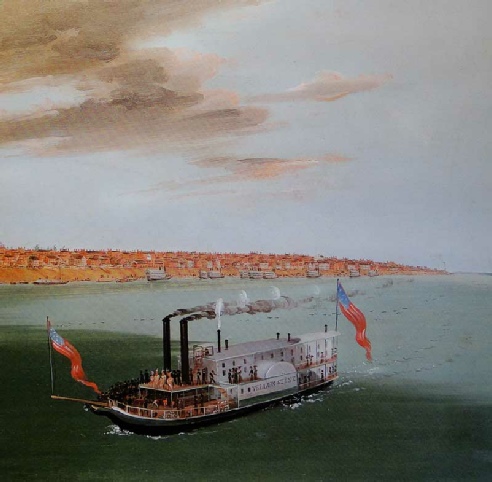Subject Guide

Mountain West
Malachite’s Big Hole
S.S. Yellow Stone:
In the summer of 1830, Kenneth McKenzie, of the American Fur Company, while on a visit downriver, suggested to Pierre Choteau, Jr. that a steamboat would be useful for transporting goods and merchandise upriver and for carrying furs and skins on the return trip. On November 24, 1830, the American Fur Company placed an order with two firms in Louisville, Kentucky for construction of the Yellow Stone. $4,000 was contracted for construction of the ship, and $4,950 for building the steam engine. She was a side wheel steamboat, weighing 144 tons, and measuring 130 feet long, by 19 feet wide and drafting 5.5 feet. The image below shows the S.S. Yellowstone leaving St. Louis in 1832 modified from a painting by George Catlin
Fuel would be a major concern for the crew and masters of the S.S. Yellow Stone while on the Missouri River. A vessel of this size burned ten cords of wood a day during a normal daylight run. On the lowest portion of the Missouri River men, known as "Woodhawks" would establish themselves near the river and offer firewood for sale to the steamboats. Further upstream it would be necessary for the Yellow Stone to make periodic layovers for the crew and engagés to go ashore and cut wood. Still further up the river, trees would become scarce, and the men would scrounge every piece of driftwood that could be had.
On it's first trip upriver the Yellow Stone carried an assortment of merchandise valued at $50,385.79. Goods included 1,000 pairs of blankets ranging from one and one-half point to three and one-half points, fabrics, 200 dozen mirrors, 126 dozen knives, 995 scalping knives, 75 dozen combs, 50 dozen corn hoes, 100 gross buttons, 4,500 pounds of blue and white beads, 25 pounds of seed beads, 300 beaver traps and chains, 1,000 half axes, 300 tomahawks, 48 American felling axes, 20 battle axes, 600 pounds of vermillion, 200 pounds of verdigris, 16 gross of clay pipes, 10,000 pounds of gunpowder, 20,000 pounds of lead and 12,000 pounds of tobacco. (If transported overland, the gunpowder, lead and tobacco alone would have required the use of 210 horses or mules).
Up until this time steamboats only ascended the Missouri River as far as Council Bluffs. The American Fur Company plan was to push up as far as the mouth of the Yellowstone River where Kenneth McKenzie was stationed at Fort Union, more than 1,800 miles upriver from St. Louis.
The first expedition of the Yellow Stone up the Missouri was to be somewhat of a disappointment to McKenzie and Choteau. Due to production delays, the company did not take delivery of the steamboat until several weeks after the contracted date. In this year and season, the Missouri River was very low. The Yellow Stone made it as far as Council Bluffs without difficulty, but by May 20th 1831, the Yellow Stone had gone nearly as far as the Niobrara River, where it could go no further due to the low water conditions. Pierre Choteau sent a man with a horse overland to Fort Tecumseh, about 240 miles upriver, to request a barge to come down and take off some of the heavier merchandise. After off-loading merchandise onto two barges, the Yellow Stone was able to continue upriver to Fort Tecumseh where it arrived on June 19th. McKenzie, on learning of the struggles of the steamboat, collected all of the furs taken in by Fort Union and Fort Clark and brought them down to Fort Tecumseh where they were waiting for the arrival of the Yellow Stone. On arrival, the Yellow Stone was immediately loaded with furs, skins and buffalo robes. The steamboat made the return trip to St. Louis in nearly two weeks.
The Yellow Stone would make its second attempt to conquer the Missouri River on March 26, 1832. This trip was notable because in addition to the usual contingent of voyageurs, hunters and trappers, it carried the artist George Catlin. (To see some of Catlin's artwork). The Yellow Stone would again need assistance from barges due to low water, however, it would eventually reach Fort Union. On it's return voyage to St. Louis the steamboat would average an astounding hundred miles per day.
For more information about the Steamboat Yellow Stone see the following:
Voyages of the Steamboat Yellow Stone, by Donald Jackson, published by Ticknor & Fields, New York, 1985.
Return to the Top
Return to Steamboats
